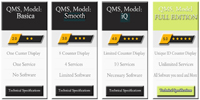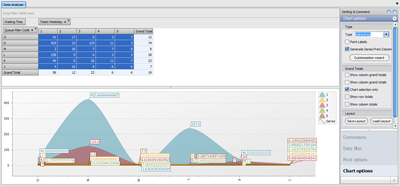What is the electronic queue management system?

What is the electronic queue management system?
People realized the importance of organizing the queue and directed it to expedite and organize the processes of obtaining service in a fair and easy manner.
The initial queuing system is a way to preserve the right of a particular customer to obtain service before others request the service after him.
The simplest type of this system was manifested by lining up people in a row, but a problem arose regarding the standing of customers for long periods, especially in big cities, which is fatigue for customers. Waiting area. An employee is assigned the task of calling the customer when their turn arrives, by tracking employee cases.
The process evolved into a completely automatic mechanism today, where call keys were placed near each employee, a large screen, and a loudspeaker, so the screen shows the required role number, and an audio call is broadcasted with the role number and the employee had to review through the speakers.
This was a lineup or simple role system, but statistics and analysis companies have noticed the importance of the data that can be obtained and that they contribute effectively for developing and increasing the speed of work through strict control mechanisms and analysis and simulation programs, so the so-called queue management systems appeared.

WHICH QUEUE MANAGEMENT SYSTEM DO I CHOOSE?
What are the purposes of the queue management systems ?
• Organizing the queue of auditors.
• Running the queue fairly according to priorities that are determined according to the current reality.
• Passing customers classified as VIPs according to a fair mechanism.
• Managing customer reception and waiting times.
• Determining when to stop receiving customers.
• Give work progress reports to assist in making decisions that raise the pace of work and evaluate employee work.
• knowing the peak times for each service as well as the recessions.
Predicting crises or recessions through analyzing reports.
• Helping with the formation of staff, their numbers, and the services they will provide thorough reporting and simulation programs.
• Knowing the level of competence of each employee.
• Know the actual working hours for each employee.
• Knowledge of the theoretical working hours for each employee.
Some people may ask, can this be done with just a queue system?
Yes, it is possible. For example, if we know the time that has passed for a specific service to be implemented for ten clients, for example, and we collect the service times for each customer separately and our resulting division is -

Related article: IMPORTANCE OF Q-LINKER DATA ANALYSIS.
Continued - number of customers We can deduce the average time that a customer who attended will request the same service and there will be clients before him.
We can also evaluate the performance of an employee when we compare the time that an employee spends compared to an employee performing the same service.
We can also know the actual number of working hours for this employee by knowing the number of clients that he served while there, given that there are enough customers waiting.

All this we got from just getting two numbers, which are the time of service implementation and the number of customers, so how about when we know the rest of the numbers that the queue management system provides?
Faisal Alotri
A special article for Q-Linker Smart Solutions
What is the electronic queue system
what is queue management in operating system
why we need queue management system
scope of queue management system
articles
qms
line-up system
data analysis

















